Related Research Articles
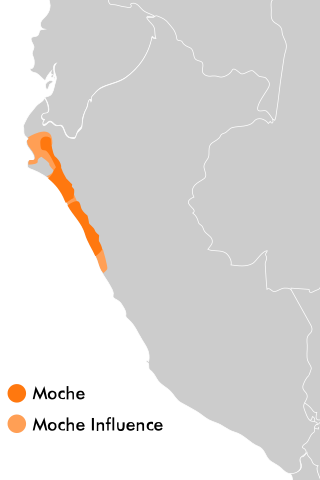
The Moche civilization flourished in northern Peru with its capital near present-day Moche, Trujillo, Peru from about 100 to 800 AD during the Regional Development Epoch. While this issue is the subject of some debate, many scholars contend that the Moche were not politically organized as a monolithic empire or state. Rather, they were likely a group of autonomous polities that shared a common culture, as seen in the rich iconography and monumental architecture that survives today.
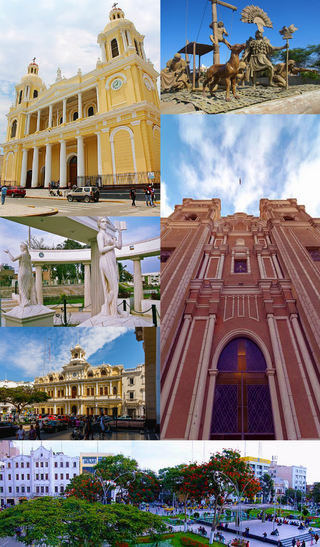
Chiclayo is the principal city and capital of the Lambayeque region and Chiclayo Province in northern Peru. It is located 13 kilometers from the Pacific coast, 208 kilometers from the city of Trujillo and 770 kilometers from the country's capital, Lima. It was founded under the name of "Santa María de los Valles de Chiclayo".

A shaft and chamber tomb is a type of chamber tomb used by some ancient peoples for burial of the dead. They consist of a shaft dug into the outcrops of rock with a square or round chamber excavated at the bottom where the dead were placed. These chambers can consist of a single shaft and chamber like the Mexican tombs or sometimes quite elaborate as was built in ancient Egypt.
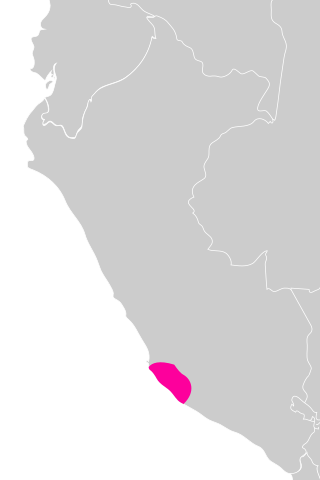
The Nazca culture was the archaeological culture that flourished from c. 100 BC to 800 AD beside the arid, southern coast of Peru in the river valleys of the Rio Grande de Nazca drainage and the Ica Valley. Strongly influenced by the preceding Paracas culture, which was known for extremely complex textiles, the Nazca produced an array of crafts and technologies such as ceramics, textiles, and geoglyphs.
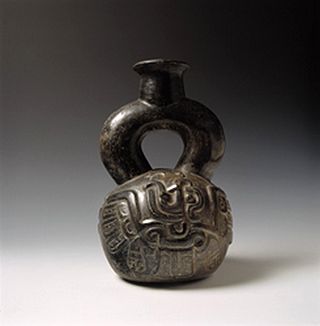
The Cupisnique culture was a pre-Columbian indigenous culture that flourished from c. 1500 to 500 BC along what now is Peru's northern Pacific coast. The culture had a distinctive style of adobe clay architecture. Artifacts of the culture share artistic styles and religious symbols with the Chavin culture that arose in the same area at a later date.

Huaca Rajada, also known as Sipán, is a Moche archaeological site in northern Peru in the Lambayeque Valley, that is famous for the tomb of Lord of Sipán, excavated by Walter Alva and his wife Susana Meneses beginning in 1987. The city of Sipán is dated from 50–700 AD, the same time as the Moche Period.
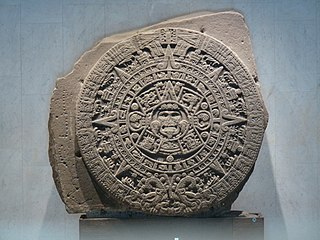
Pre-Columbian art refers to the visual arts of indigenous peoples of the Caribbean, North, Central, and South Americas from at least 13,000 BCE to the European conquests starting in the late 15th and early 16th centuries. The pre-Columbian era continued for a time after these in many places, or had a transitional phase afterwards. Many types of perishable artifacts that were once very common, such as woven textiles, typically have not been preserved, but Precolumbian monumental sculpture, metalwork in gold, pottery, and painting on ceramics, walls, and rocks have survived more frequently.

The Museo de la Nación is one of two major museums of Peruvian history in Lima, Peru. It is much larger than the other main museum in Lima, the Peruvian National Museum of Archaeology, Anthropology, and History. Currently it is no longer being used as a museum, carrying only very sporadic exhibitions.

The Lord of Sipán is the name given to the first of several Moche mummies found at Huaca Rajada, Sipán, Peru by archaeologist Walter Alva. The site was discovered in 1987.
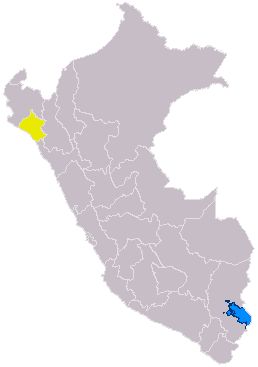
The Sican culture is the name that archaeologist Izumi Shimada gave to the culture that inhabited what is now the north coast of Peru between about 750 and 1375 CE. According to Shimada, Sican means "temple of the Moon". The Sican culture is also referred to as Lambayeque culture, after the name of the region in Peru. It succeeded the Moche culture. There is still controversy among archeologists and anthropologists over whether the two are separate cultures. The Sican culture is divided into three major periods based on cultural changes as evidenced in archeological artifacts.

Located in the Chicama Valley, the El Brujo Archaeological Complex, just north of Trujillo, La Libertad Province, Peru, is an ancient archaeological site that was occupied from preceramic times. Considering the broad cultural sequencing, the Chicama Valley can be considered as an archaeological microcosm. Research at the site benefits from the favourable environmental and topological conditions for material conservation.
Alana Kathleen Cordy-Collins was Professor of Anthropology at the University of San Diego. She was an archaeologist whose primary specialization was Peruvian prehistory.

The Wari Empire or Huari Empire was a political formation that emerged around 600 AD (CE) in Peru's Ayacucho Basin and grew to cover much of coastal and highland Peru. The empire lasted for about 500 years, until 1100 CE. It existed during the same era as the Tiwanaku culture, and at one time, was thought to have been derived from it. In 2008, archeologists found a precolumbian city, the Northern Wari ruins near modern Chiclayo. The find was the first extensive settlement related to the Wari culture discovered that far north. Archaeological discoveries have continued over the past decade. In 2023, archaeologists discovered a 1200-year-old Wari ritual complex in Arequipa. While more discoveries are being made regarding the Wari Empire, archaeologists are able to draw more conclusions about the Wari Empire's culture.

Ventarrón is the site of a 4,500-year-old temple with painted murals, which was excavated in Peru in 2007 near Chiclayo, in the Lambayeque region on the northern coast. The site was inhabited by the Early Cupisnique, Cupisnique, Chavin and Moche cultures.

The Lima culture was an indigenous civilization which existed in modern-day Lima, Peru during the Early Intermediate Period, extending from roughly 100 to 650. This pre-Incan culture, which overlaps with surrounding Paracas, Moche, and Nasca civilizations, was located in the desert coastal strip of Peru in the Chillon, Rimac and Lurin River valleys. It can be difficult to differentiate the Lima culture from surrounding cultures due to both its physical proximity to other, and better documented cultures, in Coastal Peru, and because it is chronologically very close, if not over lapped, by these other cultures as well. These factors all help contribute to the obscurity of the Lima culture, of which much information is still left to be learned.

A stirrup spout vessel is a type of ceramic vessel common among several Pre-Columbian cultures of South America beginning in the early 2nd millennium BCE.

Moche portrait vessels are ceramic vessels featuring individualized and naturalistic representations of human faces that are unique to the Moche culture of Peru.

The Andean civilizations were South American complex societies of many indigenous people. They stretched down the spine of the Andes for 4,000 km from southern Colombia, to Ecuador and Peru, including the deserts of coastal Peru, to north Chile and northwest Argentina. Archaeologists believe that Andean civilizations first developed on the narrow coastal plain of the Pacific Ocean. The Caral or Norte Chico civilization of coastal Peru is the oldest known civilization in the Americas, dating back to 3500 BCE. Andean civilizations are one of at least five civilizations in the world deemed by scholars to be "pristine." The concept of a "pristine" civilization refers to a civilization that has developed independently of external influences and is not a derivative of other civilizations.
San Jose de Moro is a Moche archaeological site in the Pacanga District, Chepén Province, La Libertad Region, of Northwestern Peru. The site served as a ceremonial funerary complex between the years 400 and 1000 AD.
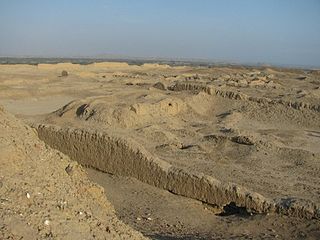
The Pacatnamu site is located at the mouth of the Jequetepeque Valley on the northern coast of Peru. Rocky cliffs protect two of its sides and a humanmade wall protects the third. This area of Peru does not have a tropical environment; it gets very little precipitation and has a mild climate, which sometime can become very humid.
References
- ↑ Kirkpatrick, Sidney D. Lords of Sipan. William Morrow & Co, 1992. ISBN 0-688-10396-0